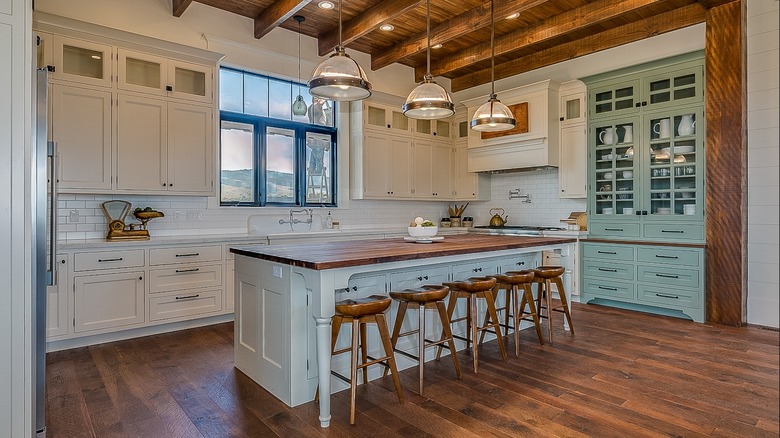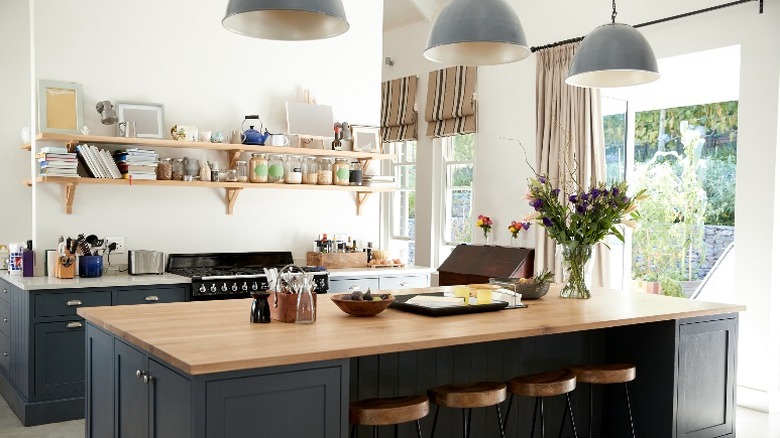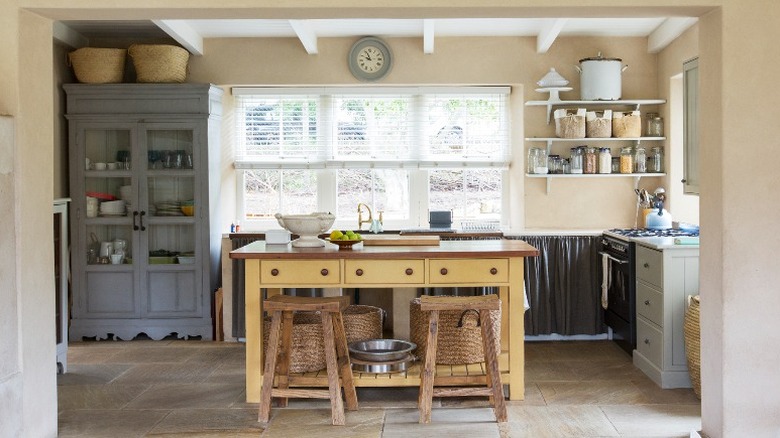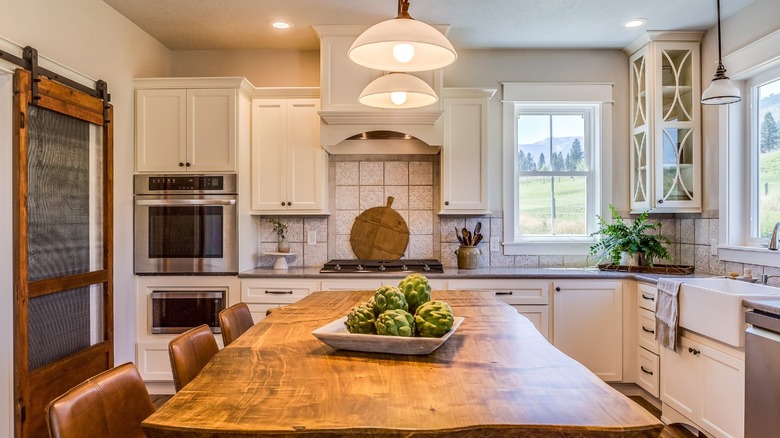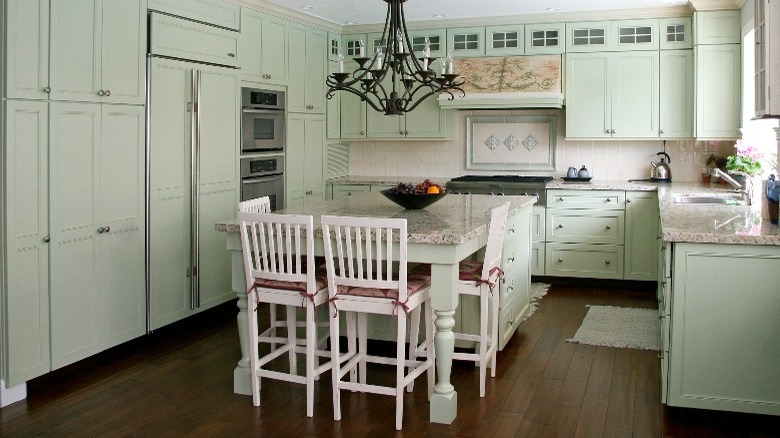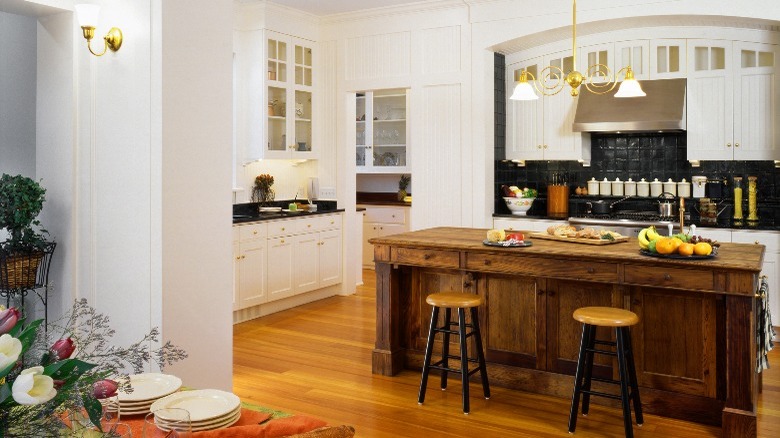5 Tips For Creating The Perfect Country Style Kitchen
What do you envision when you think of a country kitchen? Lots of wood, charming cupboards and crockery, cast-iron skillets on an oversized range, and a Dutch door to encourage a breeze while baking or simmering a big pot of stew? These are the scenes of an ideal homey kitchen — nostalgic ideas that feel like the antithesis of modern; nonetheless, they compel us to recapture them (or create them from scratch) with a warm and inviting space.
Authentic finishes and functionality are always in style, and according to My One Hundred Year Old Home, the excessively rustic and industrial modern farmhouse trend is being supplanted by a cozier and quainter one that's also aligned with a country aesthetic — cottagecore. It's softer and more reminiscent of an English cottage, 80s shabby chic, and the realness of a true family farmhouse.
Per Country Living, the mismatched, aged, and handmade factor in heavily, but so too does a contemporary chef's oven or a glowing marble countertop (stone surfaces are exemplary for rolling pie dough). There are many types and inspirations, from traditional Americana to elegant estates in bucolic settings to woodland cabins. The common threads are an overriding sense of welcome and practicality. Additionally, Richard Moore, of design firm Martin Moore, told Ideal Home that "Country kitchens respect the architecture and heritage of the property." We hone in on some of the most recognizable and appreciated elements of country kitchen design and offer tips for how to use them in your home.
Open shelving
HGTV considers open shelving to be a classic cottage element. It allows favorite and interesting objects to be highlighted while making them accessible. Additionally, it's a perfect way to introduce color and showcase seasonal decor. Country Kitchens notes that a display of useful and beautiful items imparts personality and a genuine time-collected feeling to the room. Antique mixing bowls, wooden cutting boards, baskets, and glass jars filled with pantry necessities are examples of display-worthy functional pieces.
To recreate this look, the kitchen outfitter recommends replacing upper cabinets with shelves. For a rustic space, they might be unfinished wood or live edge slabs; for something more polished, use detailed millwork capped with molding, and for vintage integrity, rest marble shelves on iron brackets. Alternately, cabinet doors can simply be removed, or solid wood panels can be swapped for glass or chicken wire. Lastly, plate racks are technically open shelves, too, and are an iconic fixture of this charming style.
Reclaimed and homey materials
According to HGTV, natural materials are a touchstone of country kitchens, with a focus on woods such as cherry, pine, oak, and maple, while Country Living says highly-grained pecky cypress is a trend to watch out for. Wood contributes warmth and a connection to nature; it's typically employed in cabinetry and dining furniture, but also frequently appears in this style of kitchen as butcher block counters. Country Kitchens explains that evidence of use gives them character, and further adds they can be less costly than other options. Chippy or milk-painted wood adds an aged quality and can be introduced by way of an island, salvaged utility cabinet, or antique pie cupboard.
Marble is a classic addition and though the stone is susceptible to staining, making it a contentious choice for a whole countertop treatment, its patina is a significant reason those who like the country style are drawn to it. A vintage marble-topped table or sideboard offers an impactful yet smaller-scale way to experience the material. Per Countertop Guides, soapstone is another long-favored material, popular for its durability and soft, milky appearance.
Lori Dennis of Dennis Design Group, Los Angeles, and star of "Real Designing Women" told HGTV that for the ultimate country kitchen style we need to "expose the rustic." She feels organic components are essential, and lists found pieces, tarnished hardware, and worn tiles as perfect examples. Dennis suggests hiring an artisan to craft something custom to ensure the space has the right amount of rustic.
A farmhouse sink
The choice of decor and appliances is elemental in creating a classic farmhouse or cottage kitchen, notes HGTV. To that end, the outlet points to the recognizable apron-front sink as a mainstay of the style. Stainless steel, concrete, copper, cast-iron, marble, and porcelain or fireclay faux porcelain are all available materials (via Magnus Home Products). Porcelain provides the biggest tie-in to vintage farmhouse fixtures, and the home improvement store explains that an alternate material called fireclay is a more durable look-alike. Per kitchen designer and outfitter Kraus, extra-deep basins enhance utility while the minimal and elegant design appeals to present-day and modern sensibilities.
Whether a stand-alone style with sculpted legs or a large utility model with attached drainboards, like this one shared by Country Living, a vintage porcelain sink will forever incite nostalgia. Its superior size, functionality, and abundant character make it a luxury in today's country-style kitchens.
Color
According to Country Kitchens, paint can significantly shift the mood in a kitchen. They note that while white is an attractive and timeless cabinet choice, pastels and bolder shades like chalkboard green, yellow, and navy blue are a pleasant surprise and lend a vintage vibe. For a classic design, you'll want to keep other components neutral and understated. In the room above, the sweetness of mint cabinetry is balanced by dark hardwood flooring, a simple tile backsplash, and neutral stone countertops. Quality millwork and finishes give this kitchen a high-end and tasteful aspect despite the unconventional paint treatment. If you're going for a quaint and fun atmosphere, abundant color is fine.
Two-toned kitchens are a great avenue for introducing color while also minimizing the amount of it. Furthermore, they create a custom and built-in appearance. Typically, upper cabinets are lightly painted or stained wood while lowers will be darkly painted or stained; Country Kitchens notes that the island might be the perfect place to try a different hue. Graeme Smith of Life Kitchens explained to Ideal Home that "mixing-and-matching color and finish creates an eclectic lived-in atmosphere needed for a rustic scheme." Crisp white and rich cherry wood is a classic combination, as is light maple with slate blue, for example. Refer to our beautiful intro image for an illustration of ivory, warm wood, and sage green used together to create a unique space. For a less permanent option, a colorful freestanding furniture piece, such as a table or cupboard, can be incorporated.
An oversized island or farm table
Authentic country kitchens were usually graced with either a large island or farmhouse table as a spot to perform food-related tasks, take meals, and gather together, per Ideal Home. The outlet advises filling the space with an oversized piece for outsized charm if possible, noting that there must be at least 36 inches of clearance around it to maintain easy traffic flow. Islands that accommodate stools offer additional seating and an invitation to keep the cook company. Those topped with soapstone or marble and finished with furniture style details like corbels and turned legs will add a refined element. Tin and butcher block tops are more rustic. A salvaged shopkeep counter or aged farmhouse table adds bona fide country charm.
Of course, these furnishings provide plenty of function in addition to their aesthetics, and that's precisely why they have endured. Islands offer storage, appliance placement, seating, and counter space, among other advantages, while a big table caters to food prep, homework, crafting, and family time. Add humble fabrics and classic patterns — cotton and linen, ginghams, and ticking — with a table cloth, placemats, or chair cushions. However you decorate it, a farmhouse table is the symbol of a warm and welcoming home.
